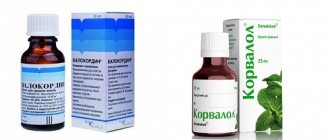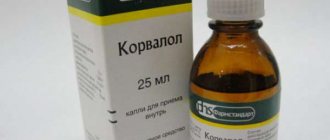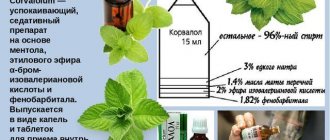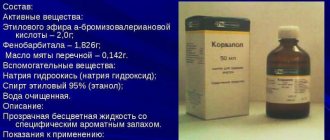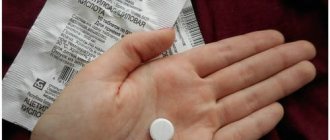Operating principle
The effect of Corvalol on the human body is due to its ingredients:
- Ethyl bromoisovalerate has a calming effect and the ability to relieve spasms in smooth muscles.
- Phenobarbital in drops acts directly on the brain as a hypnotic. It enhances the effect of other components and helps you fall asleep easier.
- Peppermint oil has a vasodilator and antispasmodic effect. This ingredient also activates the choleretic function, eliminates flatulence and has disinfecting properties.
pharmachologic effect
Corvalol is a combination drug. Its sedative and antispasmodic effect is due to the medicinal properties of its constituent substances. The drug has an excellent sedative effect and promotes natural sleep, therefore it is indicated for nervous disorders and insomnia.
: Akriderm cream and ointment: instructions, price, reviews and analogues
These properties are given to it by the ethyl ester of alpha-bromoisovaleric acid, which is a sedative (its effect is very similar to the sedative effect of valerian) and an antispasmodic effect.
Phenobarbital in the composition of the drug has an active effect on reducing the excitation of the central nervous system and, like the previous component of the drug, promotes the onset of natural sleep.
Peppermint oil also has a reflex vasodilator and antispasmodic effect. Due to the presence of these substances in the drug, you should strictly monitor the dose of the drug to avoid an overdose of Corvalol.
Composition and mechanism of action
Corvalol drops are a sedative drug with a mild effect. 1 ml of product contains the following substances:
- 18.26 mg phenobarbital;
- 7.5 mg α-bromoisovaleric acid ethyl ester (main active ingredient);
- 1.42 mg peppermint oil;
- ethanol (96%);
- distilled water.
Corvalol is a clear liquid with a strong characteristic odor.
The effect of the drug is based on the properties of all its constituent components. Phenobarbital is a psychotropic substance that affects the central nervous system. The component eliminates the excitation of the nerve endings of the brain.
The main active ingredient is ethyl bromizovalerate, which helps eliminate spasms in the tissue of internal organs and has a calming effect on the nervous system. Peppermint oil – has antispasmodic and vasodilating properties.
In addition, it helps to activate choleretic and antiseptic mechanisms and eliminate flatulence.
Derivatives of valerian rhizomes have a sedative effect on the receptors of the central nervous system, and in increased dosages they are used as a sleeping pill. For ease of use, Corvalol is also available in the form.
Main components of Corvalol
The composition of Corvalol drops includes the following components:
- phenobarbital in the amount of 18.26 mg;
- ethyl ether – 7.5 mg;
- peppermint oil – 1.42 mg;
- ethanol;
- distilled water.
The medication is presented in the form of a clear liquid that has a characteristic odor of alcohol. Each component is responsible for its positive effect on the body. Phenobarbital is a psychotropic component that affects the nervous system. Ethyl ether has an eliminating effect on the development of spasms of internal organs. Peppermint oils have antispasmodic and vasodilating effects.
Is it possible to give Corvalol to children?
Corvalol is a combination drug belonging to the group of sedative drugs, which is used in the treatment of various diseases.
In addition to the sedative effect, Corvalol has an analgesic and vasodilating effect, normalizes sleep and reduces the excitability of nerve endings. Many parents are concerned about the question of whether it is allowed to give Corvalol to their children.
There are no specific contraindications to the use of the drug, but its prescription to young children is often unfounded.
Composition and mechanism of action
Corvalol drops are a sedative drug with a mild effect. 1 ml of product contains the following substances:
- 18.26 mg phenobarbital;
- 7.5 mg α-bromoisovaleric acid ethyl ester (main active ingredient);
- 1.42 mg peppermint oil;
- ethanol (96%);
- distilled water.
Corvalol is a clear liquid with a strong characteristic odor.
The effect of the drug is based on the properties of all its constituent components. Phenobarbital is a psychotropic substance that affects the central nervous system. The component eliminates the excitation of the nerve endings of the brain.
The main active ingredient is ethyl bromizovalerate, which helps eliminate spasms in the tissue of internal organs and has a calming effect on the nervous system. Peppermint oil – has antispasmodic and vasodilating properties.
In addition, it helps to activate choleretic and antiseptic mechanisms and eliminate flatulence.
Derivatives of valerian rhizomes have a sedative effect on the receptors of the central nervous system, and in increased dosages they are used as a sleeping pill. For ease of use, Corvalol is also available in the form.
Contraindications and overdose
Corvalol is contraindicated for children in the following cases:
- if there are problems with the functioning of the kidneys and liver;
- while taking drugs that depress the central nervous system;
- with low blood pressure;
- in case of individual intolerance to the components of the drug.
Corvalol is prescribed only according to indications, because its specific properties can harm the child’s health. Long-term and uncontrolled use of Corvalol in children is unacceptable.
In case of an overdose of the drug, the following complications may develop:
- slower intestinal motility, which leads to frequent constipation;
- intoxication with bromine, which is part of Corvalol (apathy and depression appear, deterioration in health);
- damage to the mucous membrane (conjunctivitis, chronic rhinitis);
- hemorrhagic diathesis;
- damage to the central nervous system (impaired memory, speech, attention).
Side effects
With the correct dosage of the drug, no side effects are observed. In some cases, dizziness, drowsiness, and apathy may occur. With long-term use, drug dependence often occurs. With abrupt withdrawal of Corvalol, withdrawal syndrome develops.
Instructions for use and dosage for children
It is advisable to take the product before meals, dissolving the drops in a small amount of water (40-50 ml). On average, an adult is prescribed 20-40 drops 3 times a day. The minimum acceptable interval between repeated use of Corvalol should not be less than 4-6 hours. Corvalol tablets are taken 1 piece.
3-4 times a day, also before meals. In severe cases (during attacks of tachycardia), it is allowed to take 2-3 tablets at once. To increase the effectiveness and absorption of the drug, it is recommended to leave the tablet under the tongue until completely dissolved.
The duration of treatment is determined by the attending physician, depending on the degree of the disease and the general condition of the patient.
The required dosage for children is calculated depending on the age of the child. For every year of life there is one drop of the drug. Corvalol is prescribed to children only once a day. Most pediatricians do not recommend Corvalol for children under 12 years of age. But in emergency situations, this drug is also prescribed for young children.
Corvalol kid
Another form of Corvalol was developed especially for children - Corvalol Kid. This preparation contains only components of plant origin.
The product does not contain toxic chemicals, is completely safe for children of all ages, and has no side effects.
Corvalol Kid has successfully passed all clinical and scientific tests, proving its effectiveness and harmlessness.
Corvalol Kid is available in pharmacies without a prescription and is intended for children over three years of age. The main difference from regular Corvalol is the absence of phenobarbital, which is dangerous for an immature organism. The course of treatment usually ranges from 14 to 30 days. Noticeable improvements in the child’s condition appear after 10-14 days of regular use.
Children aged 3 to 6 years are prescribed 20 drops of the drug. Children over 6 years old - no more than 40 drops per day.
For effective treatment, it is recommended to follow nutritional rules: the child’s diet should contain large quantities of fresh fruits and vegetables, herbs, lettuce, nuts (especially almonds and walnuts), dried fruits, and oatmeal. It is recommended to limit the consumption of foods containing food colors and artificial flavors.
In some situations, Corvalol is an indispensable drug. It is used both in the complex treatment of diseases of the cardiovascular and nervous systems, and as a symptomatic remedy to eliminate pain.
Corvalol is also effective for children and adolescents: with increased excitability, nervousness and sleep disorders. Corvalol Kid is a convenient and safe product designed specifically for children.
Any prescription of medications should only be made by the attending physician.
Loading…
Source: https://SosudInfo.com/drugs/mozhno-li-detyam-korvalol.html
Release form
The drug is produced by many domestic pharmaceutical companies. The most popular form of Corvalol is drops. This medicine is presented in bottles containing 15, 25 or 50 ml of colorless transparent liquid with a characteristic aroma.
Corvalol is also available in tablets. One pack contains from 10 to 50 of these white round tablets. In childhood, this form is used very rarely.
Corvalol tablets
For oral administration. One tablet contains 580 micrograms of Mentha piperita oil, 8.2 milligrams of alpha-bromoisovaleric acid ethyl ester and 7.5 milligrams of phenobarbital. The composition also contains milk sugar, starch, beta-cyclodextrin, fiber and magnesium salt of stearic acid.
Corvalol drops
For oral administration. One hundred milliliters of liquid contains two thousand milligrams of alpha-bromoisovaleric acid ethyl ester, one hundred forty-two milligrams of peppermint oil and one thousand eight hundred twenty-six milligrams of phenobarbital. Ethyl alcohol (95%), water and sodium hydroxide solution are present.
Compound
Corvalol's formula includes three active ingredients:
- ethyl bromine isovalerianate (full name - ethyl ester of a-bromo isovaleric acid);
- phenobarbital;
- peppermint oil.
In addition to them, the drops contain such auxiliary components as 95% ethyl alcohol, purified water and sodium hydroxide. Additional substances in the tablets include microcrystalline cellulose, potato starch and cyclodextrin, as well as lactose monohydrate and magnesium stearate.
Previously, pharmacies sold the herbal drug Corvalol Kid, intended for children. Its main difference from regular Corvalol was the absence of phenobarbital. However, this product is not currently sold because the Ministry of Health has designated it and other products based on plant extracts from the same manufacturer as food additives with unproven safety and effectiveness.
Indications for prescribing the medication
The main indications for the use of Corvalol include:
- Problems of functioning of the cardiovascular system.
- Excessive anxiety and sleep disturbances.
- Excessive excitability.
- Mild spasms of the coronary vessels.
- Peristalsis and spasms of the gastrointestinal tract.
Corvalol, like many similar drugs, should be used exclusively as prescribed by a specialist. You can give your child Corvalol if the following factors are detected:
- If your child develops symptoms of irritability, sleep disturbances, and restlessness.
- If there are signs of heart rhythm disturbances, as well as painful spasms in the heart area.
- At a temperature that rises due to colds.
- If there are signs of intestinal colic and excessive gas formation in the baby.
With Corvalol you can eliminate pain and pain syndromes. But this drug is not a medicine that helps cure ailments. Active use of Corvalol leads to the fact that the body develops a psychological and narcotic dependence on phenobarbital.
It is important to know! Increasing the dosage or using the drug for longer than prescribed by the doctor is strictly prohibited.
The above warning is especially relevant for children, since the child’s body is very easily susceptible to the negative effects of many medications, including Corvalol. We will find out further how to use Corvalol correctly for children.
Corvalol for children under one year of age – Med-Consultation
- Drops for oral administration, 15, 25, 30 or 50 ml in dark glass dropper bottles, 1 bottle in a cardboard box;
- Tablets, 10 pcs. in blister packs, in a cardboard pack of 2 or 10 packs.
Active ingredients of the drug:
- Ethyl ester of α-bromoisovaleric acid: in 1 ml drops – 20 mg, in 1 tablet – 8.2 mg;
- Phenobarbital: in 1 ml drops – 18.26 mg, in 1 tablet – 7.5 mg;
- Peppermint oil: 1 ml drops – 1.42 mg, 1 tablet – 0.58 mg.
Auxiliary components:
- Drops: ethanol 95%, purified water and sodium hydroxide;
- Tablets: beta-cyclodextrin, lactose monohydrate, potato starch, magnesium stearate and microcrystalline cellulose.
Contraindications
For both dosage forms:
- Severe liver/renal failure;
- Lactation period (or breastfeeding should be stopped);
- Hypersensitivity to components.
Tablets are also contraindicated in the following cases:
- Pregnancy;
- Age under 18 years (there is no experience in using the drug in this dosage form in this age group);
- Lactose intolerance, lactase deficiency, glucose-galactose malabsorption (due to lactose content).
With extreme caution, Corvalol in the form of drops can be prescribed during pregnancy.
Directions for use and dosage
The drug should be taken orally before meals: tablets with water, drops dissolved in a small amount of water (30-50 ml).
Adults are prescribed 15-30 drops 2-3 times a day or 1-2 tablets 2 times a day. For tachycardia, a single dose can be increased to 40-50 drops or 3 tablets.
Children, depending on the clinical picture and age, are prescribed 3-15 drops per day.
The duration of treatment in each case is determined by the doctor individually.
Side effects
Possible side effects of Corvalol: dizziness, drowsiness, decreased ability to concentrate, slow heart rate, allergic reactions. In some cases, disorders of the gastrointestinal tract are observed. The described phenomena disappear when the dose is reduced or the drug is discontinued.
With long-term use, there is a possibility of bromine accumulation in the body and the development of bromism phenomena (manifested by symptoms such as conjunctivitis, rhinitis, hemorrhagic diathesis, apathy, depression, impaired coordination of movements), addiction, drug dependence and withdrawal syndrome.
Symptoms of overdose: decreased blood pressure, ataxia, nystagmus, agitation, depression of the central nervous system (CNS), dizziness, weakness, bromine intoxication. In this case, Corvalol should be discontinued, gastric lavage should be performed, and symptomatic therapy should be performed; if the central nervous system is depressed, caffeine and niketamide are indicated.
special instructions
During treatment with Corvalol:
- You should not drink alcoholic beverages;
- It is recommended to refrain from engaging in potentially hazardous activities, including driving vehicles.
Drug interactions
Medicines that depress the central nervous system and valproic acid enhance the effect of Corvalol.
Phenobarbital, which is part of the drug, enhances the effect of hypnotics, analgesics and local anesthetics, reduces the effectiveness of drugs metabolized in the liver, incl. griseofulvin, glucocorticosteroids, coumarin derivatives, oral contraceptives.
Corvalol increases the toxicity of methotrexate.
Main components of Corvalol
The composition of Corvalol drops includes the following components:
- phenobarbital in the amount of 18.26 mg;
- ethyl ether – 7.5 mg;
- peppermint oil – 1.42 mg;
- ethanol;
- distilled water.
The medication is presented in the form of a clear liquid that has a characteristic odor of alcohol. Each component is responsible for its positive effect on the body.
Phenobarbital is a psychotropic component that affects the nervous system. Ethyl ether has an eliminating effect on the development of spasms of internal organs.
Peppermint oils have antispasmodic and vasodilating effects.
Indications for prescribing the medication
The main indications for the use of Corvalol include:
- Problems of functioning of the cardiovascular system.
- Excessive anxiety and sleep disturbances.
- Excessive excitability.
- Mild spasms of the coronary vessels.
- Peristalsis and spasms of the gastrointestinal tract.
Corvalol, like many similar drugs, should be used exclusively as prescribed by a specialist. You can give your child Corvalol if the following factors are detected:
- If your child develops symptoms of irritability, sleep disturbances, and restlessness.
- If there are signs of heart rhythm disturbances, as well as painful spasms in the heart area.
- At a temperature that rises due to colds.
- If there are signs of intestinal colic and excessive gas formation in the baby.
Source: //zdorovo.live/krov/korvalol-detyam-do-goda.html
Is it possible to give Corvalol to children?
Corvalol is a combination drug belonging to the group of sedative drugs, which is used in the treatment of various diseases.
In addition to the sedative effect, Corvalol has an analgesic and vasodilating effect, normalizes sleep and reduces the excitability of nerve endings. Many parents are concerned about the question of whether it is allowed to give Corvalol to their children.
There are no specific contraindications to the use of the drug, but its prescription to young children is often unfounded.
Contraindications and overdose
Corvalol is contraindicated for children in the following cases:
- if there are problems with the functioning of the kidneys and liver;
- while taking drugs that depress the central nervous system;
- with low blood pressure;
- in case of individual intolerance to the components of the drug.
Corvalol is prescribed only according to indications, because its specific properties can harm the child’s health. Long-term and uncontrolled use of Corvalol in children is unacceptable.
In case of an overdose of the drug, the following complications may develop:
- slower intestinal motility, which leads to frequent constipation;
- intoxication with bromine, which is part of Corvalol (apathy and depression appear, deterioration in health);
- damage to the mucous membrane (conjunctivitis, chronic rhinitis);
- hemorrhagic diathesis;
- damage to the central nervous system (impaired memory, speech, attention).
Corvalol for children under one year old – Medicine – great!
Corvalol is a combination drug belonging to the group of sedative drugs, which is used in the treatment of various diseases.
In addition to the sedative effect, Corvalol has an analgesic and vasodilating effect, normalizes sleep and reduces the excitability of nerve endings. Many parents are concerned about the question of whether it is allowed to give Corvalol to their children.
There are no specific contraindications to the use of the drug, but its prescription to young children is often unfounded.
Can Corvalol be used in children?
The drug works due to the presence of the following components:
- phenobarbital reduces the irritating effect on the brain and, depending on the dose and frequency of administration, causes hypnotic, sedative or tranquilizing effects;
- ethyl ester of -bromoisovaleric acid exhibits a sedative effect by influencing receptors mainly in the oral cavity and nasopharynx, as well as a local antispasmodic effect on vascular muscles;
- Peppermint oil reflexively dilates mainly blood vessels in the heart and brain, causes a sedative and slight choleretic effect, eliminates flatulence, and enhances intestinal function.
Corvalol is generally well accepted and rarely has side effects that can be easily managed with dose adjustments. Therefore, the drug can be used in pediatric practice. Corvalol for a child is prescribed for increased tone of the nervous system, tachycardia, dysfunction of the cardiovascular system, anxiety and emotional overexcitation. It is also effectively used for vegetative-vascular dystonia, which manifests itself as discomfort in the heart area, periodic pressure surges, and headaches.
Do not forget that the use of Corvalol can cope with the symptoms of these diseases, but does not eliminate the cause. Therefore, you should not prescribe treatment yourself; be sure to undergo examinations and consult a doctor.
In addition, you need to remember situations when Corvalol is contraindicated for children:
- dysfunction of the liver and kidneys;
- low blood pressure;
- allergic reactions or intolerance to the components that make up the drug;
- simultaneous use with other medications that affect the nervous system.
At what age is it allowed?
Doctors' opinions on the permissible age for using Corvalol differ. Some experts claim that the liquid form of this medicine can be used for all children, selecting the dosage according to the number of years of the small patient. Other doctors believe that Corvalol should only be given to children over 12 years of age. They argue that earlier use is not advisable, despite the reduced dose of drops.
Corvalol for children: is it possible and what is the dosage?
Should Corvalol be given to children? This question is asked by many mothers and fathers. And this is not surprising, because the drug has a whole range of useful properties.
It calms, relieves pain, dilates blood vessels and helps cope with insomnia. The remedy is used in the treatment of many diseases. It is practically harmless. But in some cases it is not recommended to drink it.
Why? When can and when can’t Corvalol be used for children?
general information
So, Corvalol is a sedative medicine.
It contains the following ingredients:
- phenobarbital;
- ethyl ester of α-bromoisovaleric acid;
- peppermint oil (peppermint);
- ethanol;
- water (usually distilled).
The release form of the product is colorless drops with a specific odor or tablets.
The drug owes its effect on the body to the properties of each of the components:
- Phenobarbital has a powerful effect on the nervous system. It slows down the process of transmission of excitation impulses to the brain. Helps you calm down and fall asleep.
- α-bromoisovaleric acid ethyl ester is the main component. It has an antispasmodic effect and effectively calms.
- Peppermint oil, like ethyl ester, produces an antispasmodic effect and also perfectly dilates blood vessels.
Among other things, the substance improves intestinal function, for example, helping in the fight against flatulence. It is noteworthy that the oil also has a good effect on the condition of the oral cavity. It has a mild antiseptic effect and freshens breath.
The effect of taking Corvalol appears approximately 15 minutes after consumption. This applies to all forms of its release.
When is it allowed and when is it prohibited to take Corvalol?
When is the medicine given? It may be prescribed if:
- disruptions in the functioning of the heart and blood vessels;
- neurosis;
- excessive excitability;
- sleep problems;
- anxiety;
- tachycardia;
- vascular spasms;
- stage 1 hypertension;
- high tone of the nervous system;
- spasms of the stomach and other organs of the gastrointestinal tract (gastrointestinal tract).
Corvalol is prescribed to children for the following indications:
- restlessness, frequent irritability;
- atypical reaction of the child’s body to vaccination;
- increased temperature with a cold;
- heartache;
- colic;
- intestinal problems.
It is worth remembering that the medicine will help get rid of these unpleasant symptoms. However, it will not cure the cause of their appearance. Therefore, for a complete recovery, it is necessary to undergo an examination and, if necessary, a course of complex treatment.
There are cases when taking Corvalol for a child is strictly contraindicated:
- Problems with the kidneys and liver.
- If other drugs that affect the nervous system are used in treatment.
- Low blood pressure.
- Allergy or intolerance to one of the ingredients included in the medication.
The doctor decides how advisable it is to take Corvalol drops or tablets.
He also determines the dosage and duration of treatment.
Instructions, side effects and overdose
Treatment with Corvalol is prescribed by a doctor. He also calculates the dose and duration of use of the medicine.
Instructions for use for drops and tablets are different:
- It is better to drink Corvalol drops before meals once a day, stirring them with water.
- The tablets should be taken three times a day.
Single dose - 1 tablet. In case of complications, for example, rapid heartbeat, it can be increased. To make the effect of the tablets appear faster, it is recommended to place them under the tongue.
How does a doctor calculate a single dose? Usually for each year of the child there is 1 drop of Corvalol.
You need to take it once a day, not more often.
Many experts do not recommend prescribing the drug to children under 12 years of age. However, sometimes its use will still be justified.
If you exceed the dose prescribed by your doctor, an overdose may occur.
This condition can be identified by its characteristic symptoms:
- bowel problems such as constipation;
- lethargy, reluctance to do anything;
- deterioration in general health;
- diathesis;
- chronic runny nose, conjunctivitis;
- speech disorders, memory problems, difficulty concentrating.
It is worth noting that Corvalol has virtually no side effects. Sometimes drowsiness and dizziness occur. In addition, with prolonged treatment, addiction may develop.
Can Corvalol be given to children? Yes, this is allowed. This drug should be given its due: in a fairly short period of time it will improve intestinal function, calm the child, and solve sleep problems. However, you should be careful. Corvalol contains substances that may cause side effects. You can protect yourself from them if you strictly follow medical prescriptions.
Source: https://BolezniKrovi.com/serdce/preparaty/korvalol-detyam.html
Application of Corvalol
If a doctor has prescribed Corvalol for a child, then parents should know the main features of using this medication. It is advisable to give Corvalol to your baby before meals. In this case, the drops must be dissolved in water, the amount of which should be 40-50 ml. How much Corvalol should be taken for children? The dosage for an adult corresponds to 20-40 drops of Corvalol, which should be taken 3 times a day. Moreover, it is important to maintain an interval between subsequent uses of the drug, which should not be less than 6 hours.
If complications occur, adults are allowed to take Corvalol in tablet form, 2-3 tablets per dose. To increase the effectiveness of the medication, it is necessary to place the tablet under the tongue until it is completely dissolved. For children, the dosage of the drug is prescribed by the attending doctor. Moreover, the dosage is calculated based on the age of the children. For each year of a baby's life, one drop of Corvalol is required. The medication is given only once a day.
It is important to know! Many pediatricians do not recommend giving this drug to children under 12 years of age. They resort to his help only in emergency situations.
Use of Corvalol in newborns and infants
Despite the relative safety of the drug, Corvalol is prescribed to newborns quite rarely and with great caution.
Parents sometimes give medicine for the baby's restlessness, poor sleep, and frequent painful colic. Also used for elevated body temperature (for example, after vaccination), and for intestinal spasms. It must be remembered that Corvalol is used for children only in drops. This form of release of the drug contains ethyl alcohol, so frequent uncontrolled use in an infant is very dangerous for health: allergies, intoxication, and drug dependence may occur.
Pediatricians do not recommend taking Corvalol to children under 12 years of age, but in some cases it is prescribed from 3 years of age. For young children, there are other, safer drugs that can cope with the problem of anxiety, spasm, and hyperthermia.
Corvalol KID for children
For children, there is a special form of the drug called Corvalol Kid. This medication contains exclusively substances of plant origin. Its composition completely excludes toxic and chemical components that can cause serious damage to the health of the baby.
Corvalol KID is a completely safe medicine that can be given to children of all ages. Its main advantage is the absence of side symptoms. Scientific studies have been conducted on the effect of the medication on the child’s body. Based on clinical studies, it was found that the product is not only harmless and safe, but also effective.
Corvalol Kid can be bought at any pharmacy, as the drug is available without a prescription. The medication can be used by children over 3 years of age, but only as prescribed or recommended by a specialist.
If the baby’s temperature is above 39 degrees, then the drug can be given to the child in the required quantity.
What quantity to give preference to when treating with Corvalol should be found in the instructions or from the treating doctor.
It is important to know! Corvalol Kid can be given to children for 1 month, due to the absence of phenobarbital in its composition.
Doses used
Corvalol is available in tablets and drops. Older children over 12 years of age can take it in tablets (it is recommended not to drink them with water, but to dissolve them) one 3 times a day or, for example, only during an attack of heart pain or high blood pressure. The tablet preparation is more convenient to use; you do not need to carry water with you and count the number of drops.
Corvalol in drops is given to children, it is much more convenient, especially for infants. The dose is calculated according to age - 1 drop per year of life. For example, if the child is 5 years old, then the dose will consist of 5 drops. The drug can be dropped onto a small piece of sugar or dissolved in 30-40 milliliters of liquid, preferably washed down with water. The substance is quickly absorbed into the oral mucosa and begins to act within 5-10 minutes. The duration of the effect lasts 3-6 hours.
The duration and frequency of taking Corvalol is decided only by a doctor. Self-medication, uncontrolled increase in dose and duration of drug use can lead to overdose. Its common symptoms are:
- hemorrhagic rashes on the skin and mucous membranes;
- deterioration of intestinal motility and, as a result, constipation;
- the composition includes bromine (in the form of a-bromoisovaleric acid), with its intoxication drowsiness, apathy, and depression appear;
- damage to the mucous membranes: vasomotor rhinitis, conjunctivitis;
- damage to the nervous system in the form of memory impairment, speech impairment, and attention.
Use of Corvalol in newborns and infants
Despite the relative safety of the drug, Corvalol is prescribed to newborns quite rarely and with great caution. Parents sometimes give medicine for the baby's restlessness, poor sleep, and frequent painful colic. Also used for elevated body temperature (for example, after vaccination), and for intestinal spasms.
It must be remembered that Corvalol is used for children only in drops. This form of release of the drug contains ethyl alcohol, so frequent uncontrolled use in an infant is very dangerous for health: allergies, intoxication, and drug dependence may occur.
Pediatricians do not recommend taking Corvalol to children under 12 years of age, but in some cases it is prescribed from 3 years of age. For young children, there are other, safer drugs that can cope with the problem of anxiety, spasm, and hyperthermia.
Analogues of Corvalol
Instead of Corvalol drops for the heart, you can use Valocordin. This is a German medicine that is available in the form of an alcohol tincture. Its therapeutic effect is provided by phenobarbital and ethyl bromizovalerianate. As additional components, the drops contain ethyl alcohol, water, mint and hop oil.
Valocordin has the same indications for use as Corvalol, but it has other contraindications. The German remedy should not be taken if:
- hypersensitivity to the composition of the drug;
- severe liver and kidney dysfunction;
- age under 18 years;
- period of pregnancy and breastfeeding.
Due to the ethyl alcohol content, Valocordin should be drunk with caution if you have:
- pathologies of the liver and nervous system;
- alcohol addiction;
- head injuries.
Valocordin differs from Corvalol drops in its dosage regimen. It should be drunk before meals with a small amount of water. Most patients are prescribed the medicine from 15 to 20 drops three times a day. For patients suffering from insomnia, Valocordin is prescribed in a single dose of 30 drops.
Another difference between Valocordin and Corvalol tincture is the storage conditions. The German remedy does not lose its therapeutic effect at a temperature of 15-25 degrees for 5 years from the date of release.
Barboval has a similar effect to Corvalol drops. This Ukrainian medicine is produced in drops containing levomenthol, phenobarbital and ethyl bromisovalerianate as the main components. In addition to them, the drops contain water, ethanol and sodium acetate.
The main difference between Barboval and Corvalol drops is that it is not suitable for children.
You need to drink the Ukrainian drug half an hour before meals. The medicine can be diluted in a small volume of liquid or dripped onto a piece of sugar and placed under the tongue.
A single dosage can vary from 10 to 15 drops. You should drink Barboval 2 or 3 times a day. The duration of therapy is determined for each patient individually.
After a 2-week break, treatment can be repeated.
The shelf life of Barboval is 36 months. The medicine can be stored at temperatures up to 20 degrees.
Taking an analogue instead of Corvalol is permissible only with the permission of a doctor.
Sources
- https://o-krohe.ru/uspokaivayushchie-preparaty/korvalol/
- https://ozdorovue.ru/korvalol-detjam-pri-vysokoj-temperature-osobennosti-primenenija-medpreparata.html
- https://temperatura03.ru/lechenie/korvalol-detyam-pri-vysokoj-temperature.html
- https://cardiograf.com/preparaty/spazmolitiki/korvalol-detyam.html
[collapse]
Instructions for use
Corvalol tablets
The dose is set individually. Take orally, before meals, with water. Adults are usually prescribed 1-2 tablets 2 times a day. For tachycardia, the single dose can be increased to 3 tablets. The maximum daily dose is 6 tablets. The duration of use of the drug is determined by the doctor individually.
Drops Corvalol
Intended for oral administration. A pre-single dose of drops is diluted with a small amount of water (about 20 ml). According to the instructions, a single dose of the drug is 15-25 drops 3 times a day. If necessary, under the supervision of a doctor, a single dose of the drug can be increased to 50 drops. For patients aged 12 years, a single dose of the drug should not exceed 15 drops.
The duration of treatment with Corvalol is determined by the doctor on a strictly individual basis.
How many times a day can you take the drug?
When asked how often you can take Corvalol, doctors answer that the frequency of use depends on the indications. In some cases, a single dose of medication is sufficient; in some cases, tablets/drops should be taken up to 3 times a day.
: Losartan tablets: instructions, price and reviews
By
Corvalol: basic information
The drug is available in the form of tablets and drops. The main components of the drug: essential peppermint oil, phenobarbital, ethyl ester of α-bromisvaleric acid, additional components.
Mint dilates blood vessels, eliminates spasms, and disinfects. This component irritates the cold receptors on the inner lining of the mouth, dilates the heart and brain vessels. In addition, the substance eliminates bloating and enhances intestinal motility.
Phenobarbital enhances the sedative effect of other ingredients, eliminates central nervous system stimulation, and has a hypnotic effect. Ethyl ester of α-bromoisovaleric acid soothes and eliminates spasms due to irritation of the receptors of the oral and nasal cavity.
The tablets are taken orally before meals with 100 ml of water. Dosage for adults – 1 or 2 pieces twice in 24 hours. If the patient has tachycardia, then the dosage is increased to 3 tablets. You can take a maximum of 6 pills per day.
Drops are also used before meals, the medicine is diluted with water. The daily portion for adults is from 15 to 30 drops per 50 – 100 ml of warm water twice or thrice. For tachycardia, the dosage is increased to 50 drops. Children are allowed to give from 3 to 15 drops after consultation with the doctor. The final dosage and duration of treatment is determined by the doctor.
Can a nursing mother take Corvalol?
Corvalol is used for heart pain and emotional turmoil, but its composition is not at all harmless, and may force you to remove the drug from your personal medicine cabinet.
Phenobarbital contained in Corvalol belongs to the group of Barbiturates and has a nonspecific inhibitory effect on the nervous system. In addition to sedative and tranquilizing effects, the drug has vasodilating and antispasmodic effects. It tends to cause drug addiction with prolonged uncontrolled use, and, if the maximum dose is exceeded, it can deeply suppress the functioning of the central nervous system (CNS) and respiration.
Ethyl ester of alpha-bromovaleric acid has a reflex effect, irritating the receptors of the mucous membrane of the mouth and nasopharynx, thereby increasing the threshold of excitability of the central nervous system and increasing the inhibition of neurons in the cortex and nuclei of the brain (subcortex). Long-term use leads to bromine intoxication.
In addition to the active substances, the medicine contains 96% ethyl alcohol as an auxiliary base.
For a woman, a single dose of Corvalol will not cause any harm. However, all components of the drug actively penetrate into breast milk during feeding, and the child passively consumes a medicine that he does not need at all. The effect of phenobarbital is especially pronounced - the baby becomes lethargic and drowsy, even to the point of stopping breathing due to depression of the nerve centers in the brain. In this case, it is very difficult to independently restore the function of external respiration. There is also evidence that long-term use of small doses of phenobarbital leads to disruption of the cortex, and therefore to developmental delays.
Nevertheless, it is fair to note that Phenobarbital, as a stimulator of liver enzymes, is used by neonatologists (newborn pediatricians) to treat jaundice caused by the breakdown of red blood cells in the child’s blood. But in this case, the doctor calculates the correct dosage and duration of use, and the baby is constantly monitored.
If you are concerned about anxiety, irritability, or decreased resistance to stress, contact your general practitioner or antenatal clinic. Such symptoms may be the first signs of postpartum depression, which should be brought under control as early as possible. The lactation period is a difficult but joyful time for a woman, and asking for help from family and doctors becomes normal. An obstetrician-gynecologist will help you choose an anti-stress drug that does not pass into breast milk, for example, Persen, Novopassit, Glycised, Valerian, Alora.
If heart pain is associated with pathology of the cardiovascular system, it is necessary to immediately diagnose and prescribe treatment that affects the cause, and not the symptoms.
The criteria for selecting a medicine are the absence of alcohol in the composition and the mildest effect.
Remember that during lactation it is best to refrain from drug therapy unless there is an urgent need for it.
Features of use and dose
If you nevertheless decide to take Corvalol during lactation, make sure that you do not breastfeed the baby for two days - this is how long it takes to remove phenobarbital from the mother’s body.
At the same time, for a baby this process will take 7 days! To maintain lactation, it is necessary to express regularly and prepare adapted milk formulas for the child. Also, you should not engage in activities that require high concentration and rapid mental reactions, such as driving a car.
It is necessary to avoid simultaneous consumption of alcoholic beverages.
If after using the drug the pain in the heart does not decrease, you should take a nitroglycerin tablet, and if it also does not give an effect, seek medical help.
Corvalol is taken on a piece of sugar, or dissolved in water, 2-3 times a day, 15-30 drops. Exceeding this dose is not recommended.
Corvalol for children with high fever: features of the use of the drug
The drug Corvalol is a complex drug that belongs to the category of sedative medications and is used to treat various types of ailments. Most parents wonder whether it is possible to give Corvalol to children at high temperatures? Let's analyze the drug and find out whether it can be given to children at high temperatures.
Main components of Corvalol
The composition of Corvalol drops includes the following components:
- phenobarbital in the amount of 18.26 mg;
- ethyl ether – 7.5 mg;
- peppermint oil – 1.42 mg;
- ethanol;
- distilled water.
The medication is presented in the form of a clear liquid that has a characteristic odor of alcohol. Each component is responsible for its positive effect on the body.
Phenobarbital is a psychotropic component that affects the nervous system. Ethyl ether has an eliminating effect on the development of spasms of internal organs.
Peppermint oils have antispasmodic and vasodilating effects.
Dosage for children
Children aged 3 to 6 years can be given the medicine in the amount of 20 drops per day. Over the age of 6 years, you can give Corvalol KID in the amount of 40 drops. It is important to take into account that the baby’s diet should include fresh fruits, vegetables, herbs, and nuts. These food products help reduce the negative impact of Corvalol on the children's body.
Corvalol is an indispensable medicine that can save a person’s life. Most often, it is used for diseases of the heart and vascular system, as well as to eliminate pain.
If parents have the opportunity to limit their child from using Corvalol, then it is better to do this without hesitation.
As a last resort, it is better to replace regular Corvalol with children's one, which does not cause side symptoms and has a high rate of positive effects on the body.
Source: https://temperatura03.ru/lechenie/korvalol-detyam-pri-vysokoj-temperature.html


